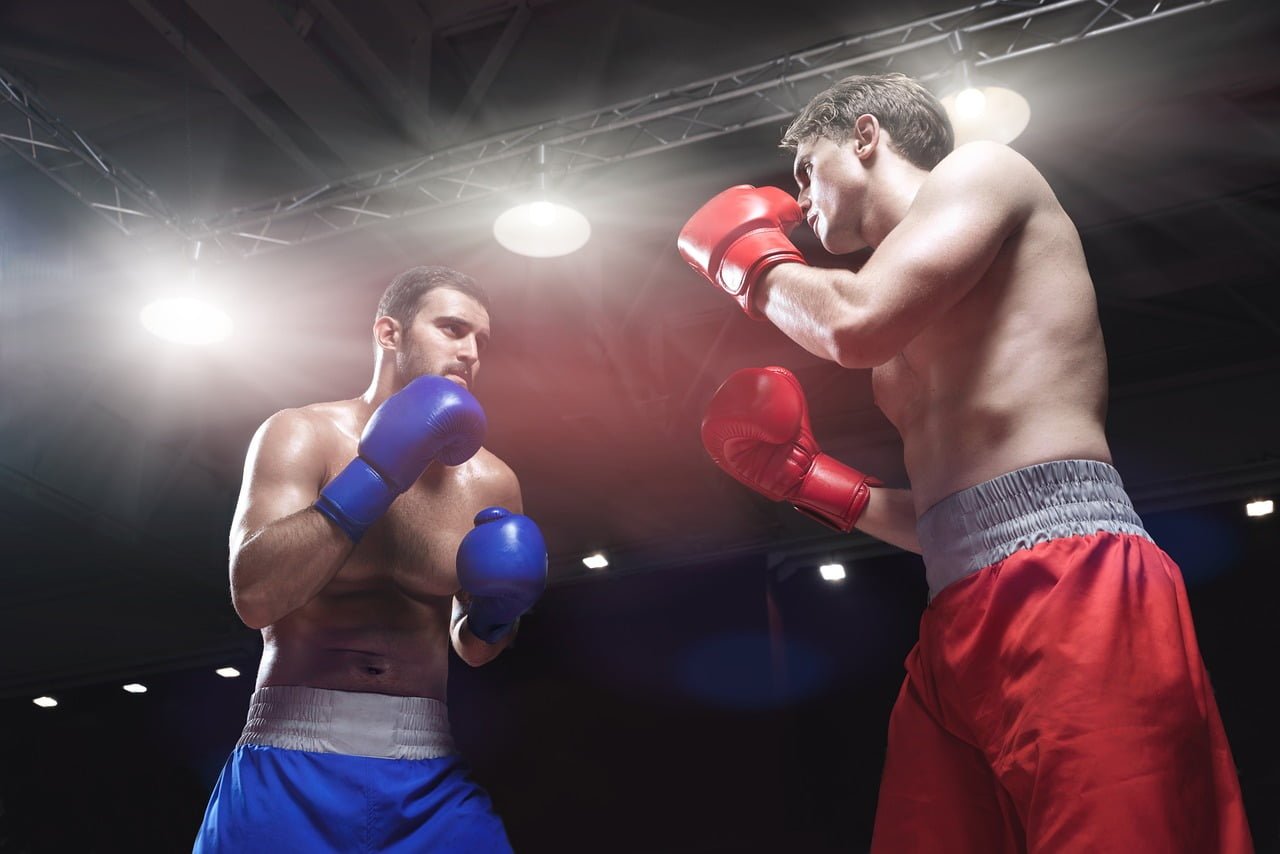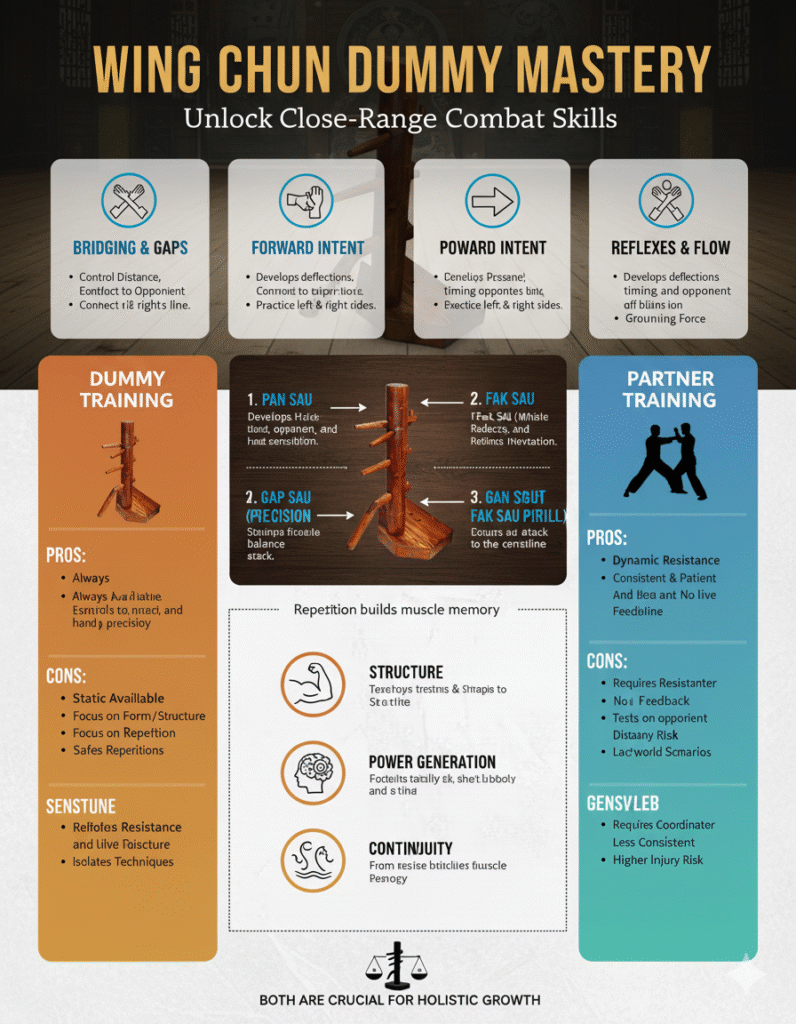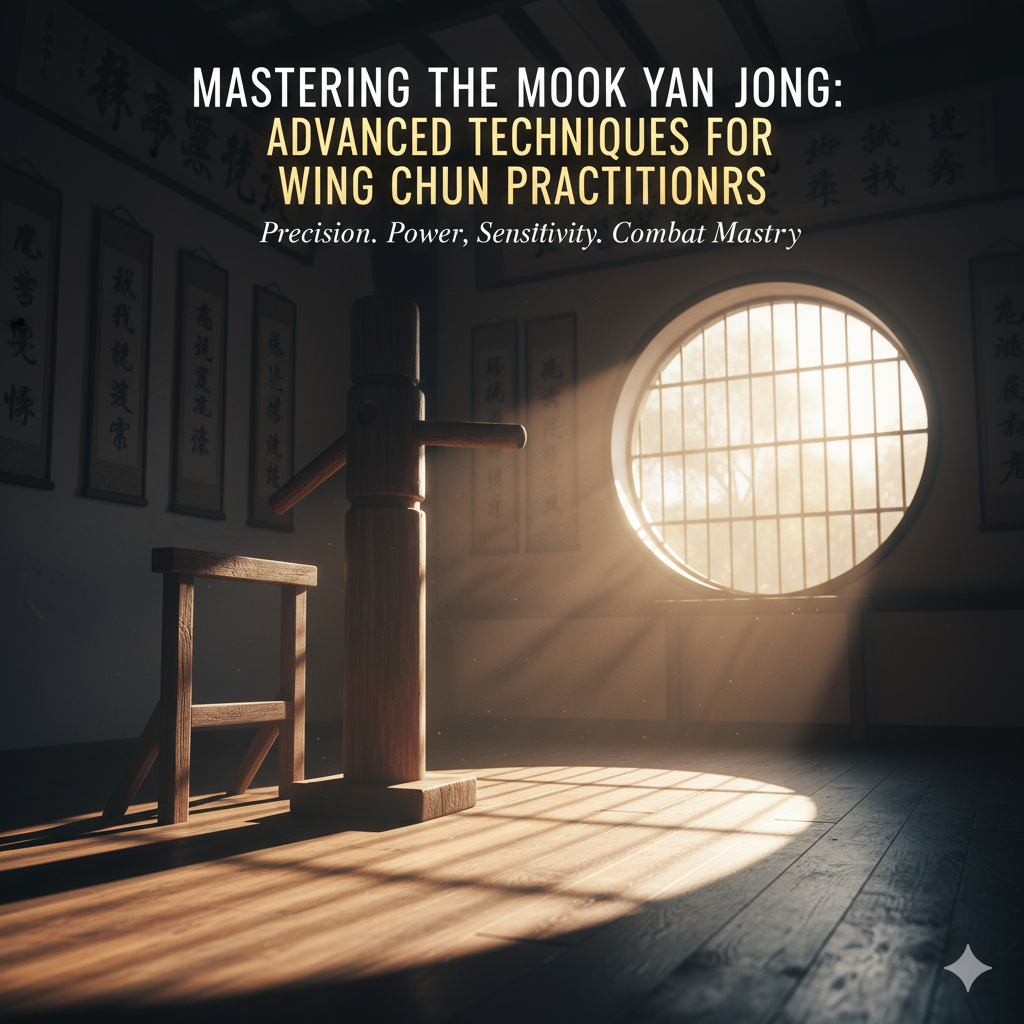Wing Chun Stages
Wing Chun, a traditional Southern Chinese kung fu style, has garnered worldwide recognition for its efficiency and economy of movement.
Originating in the Shaolin temple, Wing Chun was developed by a Buddhist nun named Ng Mui and later refined by martial artists such as Leung Jan and Ip Man.
This martial art emphasizes the principles of simultaneous attack and defense, making it a formidable and practical combat system.
Central to Wing Chun is the concept of the centerline theory.
This theory posits that the shortest path between two points is a straight line, and thus, the most effective way to both attack and defend is along this centerline.
By controlling the centerline, practitioners can maintain a strategic advantage over their opponents.
Additionally, Wing Chun stresses the importance of relaxation.
Unlike other martial arts that may rely on brute strength, Wing Chun teaches practitioners to use their opponent’s force against them, emphasizing fluidity and adaptability in movements.
The philosophy behind Wing Chun is deeply rooted in the idea of economy of motion.
Every movement in Wing Chun is designed to be as efficient as possible, minimizing wasted energy and maximizing impact.
This makes it an ideal combat system for individuals of all sizes and strengths, as it does not rely on physical prowess but rather on technique and strategy.
Wing Chun training is structured progressively, beginning with the basics and advancing to more complex techniques.
The journey typically starts with forms such as Siu Nim Tao, which lays the foundation for proper stance, hand movements, and breathing techniques.
As practitioners advance, they move on to more intricate forms like Chum Kiu and Biu Jee, which introduce advanced footwork, power generation, and recovery techniques.
Alongside these forms, practitioners also engage in Chi Sao (sticky hands) drills, which develop sensitivity and reflexes essential for close-quarters combat.
In summary, Wing Chun is a comprehensive martial art that combines philosophical principles with practical techniques.
Its emphasis on efficiency, relaxation, and centerline control makes it a unique and effective system for self-defense.
The structured progression of training ensures that practitioners develop a deep understanding of both the physical and theoretical aspects of the art, paving the way for mastery over time.
Beginner Stage: Foundation Building and Basic Techniques
In the initial stage of Wing Chun training, students focus on building a solid foundation through the mastery of fundamental techniques and principles.
This phase is crucial as it sets the groundwork for all future learning and proficiency in Wing Chun.
The training begins with the basic stance known as Yee Jee Kim Yeung Ma, which emphasizes stability, balance, and the correct alignment of the body.

Proper footwork is also introduced to ensure that the practitioner can move efficiently and maintain balance during combat.
A central component of this stage is Siu Nim Tao, the first form in Wing Chun. Siu Nim Tao translates to “little idea” and is designed to teach students the basic hand movements and positions essential for the system.
This form focuses on developing relaxation, structure, and the ability to generate power from a relaxed state.
Practitioners learn to execute techniques such as Tan Sau (palm-up hand), Bong Sau (wing arm), and Fook Sau (bridging arm), which are fundamental to Wing Chun’s defensive and offensive strategies.
The importance of proper body structure cannot be overstated in Wing Chun.
Beginners are taught to maintain a relaxed yet strong posture, which allows for efficient energy transfer and minimizes the risk of injury.
The concept of relaxation is emphasized throughout the training, as tension can hinder movement and reduce effectiveness.
Consistent practice of these principles helps to ingrain them into the practitioner’s muscle memory, making them second nature.
The typical duration for the beginner stage in Wing Chun ranges from 6 months to 1 year.
This timeframe can vary depending on the individual’s dedication, practice frequency, and ability to grasp the concepts.
Regular training, combined with mindful practice, is essential for progressing to the next stage.
Instructors often encourage students to practice daily, even outside of formal classes, to ensure continuous improvement and a deeper understanding of the foundational techniques.
Intermediate Stage: Developing Coordination and Sensitivity
The intermediate stage of Wing Chun training marks a pivotal point in a practitioner’s journey, characterized by an emphasis on refining techniques and enhancing both coordination and sensitivity.
At this stage, students begin to delve deeper into the practical applications of their foundational skills, transitioning from basic movements to more complex interactions.
One of the core practices in this phase is Chi Sao, or “sticking hands.”
Chi Sao is essential for developing tactile reflexes and responsiveness.
allowing practitioners to maintain continuous contact with an opponent and react instinctively to changes in pressure and position.
This drill hones the ability to sense and respond to an opponent’s movements, fostering a heightened sense of awareness and adaptability.
Partner drills play a crucial role in this stage, as they provide a dynamic environment for applying techniques in a controlled yet unpredictable setting.
Through these drills, students learn to coordinate their movements with a partner, improving timing, precision, and fluidity.
The interactive nature of partner work helps to build a deeper understanding of body mechanics and the principles of energy flow in combat scenarios.
A significant milestone in the intermediate stage is the introduction of the second form, Chum Kiu.
Literally translating to “Seeking the Bridge,” Chum Kiu serves as a bridge between basic techniques and more advanced applications.
This form focuses on developing the practitioner’s ability to move in a coordinated manner while maintaining balance and control.
Chum Kiu also introduces concepts such as turning and stepping, which are vital for effective defense and counterattacks in real-life situations.
The intermediate stage typically spans around 1 to 2 years, depending on the individual’s dedication and frequency of practice.
During this period, practitioners build a solid foundation of coordination and sensitivity, preparing them for the more advanced stages of Wing Chun training.
The skills acquired in this stage are crucial for progressing to higher levels of mastery, where the focus shifts to integrating and applying these refined techniques in more complex and dynamic contexts.
Advanced Stage: Enhancing Power and Precision
At the advanced stage of Wing Chun, practitioners shift their focus towards refining power, precision, and fluidity in their techniques.
This stage is marked by an in-depth study of the third form, Biu Jee, which emphasizes emergency techniques and the critical concept of recovering the centerline.
Biu Jee, often referred to as “thrusting fingers,” is pivotal in teaching advanced students how to respond effectively when their centerline control is compromised.
It introduces methods for regaining positional advantage and delivering powerful counter-attacks, making it indispensable for high-level practitioners.

Advanced Chi Sao (sticky hands) drills further enhance a practitioner’s sensitivity and reaction time.
These drills are designed to improve one’s ability to read and respond to an opponent’s movements with greater accuracy and speed.
By engaging in complex Chi Sao exercises, practitioners develop an intuitive understanding of energy flow and pressure, which are essential for maintaining control in close combat scenarios.
Wooden dummy training is another cornerstone of the advanced stage.
The wooden dummy, or “Muk Yan Jong,” is used to practice and perfect techniques with precision and power.
This training tool helps practitioners develop proper structure, timing, and positioning.
The repetitive nature of wooden dummy training also conditions the body to deliver strikes with maximum efficiency while reinforcing muscle memory.
In addition to technical drills, conditioning exercises play a crucial role at this stage.
These exercises are designed to enhance overall strength, endurance, and resilience.
Conditioning routines often include a combination of traditional and modern training methods, such as weight training, cardiovascular exercises, and plyometrics.
The goal is to build a well-rounded physique capable of executing Wing Chun techniques with greater force and precision.
The duration of the advanced stage typically ranges from 2 to 4 years, varying based on individual progress and commitment.
Consistent practice, dedication, and a willingness to push beyond one’s limits are essential for mastering this stage and advancing towards Wing Chun expertise.
Expert Stage: Mastery and Application
The expert stage in Wing Chun represents the culmination of years of dedicated practice, where practitioners synthesize all forms, techniques, and principles into an integrated and cohesive skill set.
At this level, continuous practice and refinement are crucial, as the martial artist seeks not just proficiency but true mastery.
This stage often spans from 5 to 10 years or more, emphasizing the depth of commitment required.
One of the key aspects of reaching the expert stage is the importance of real-world application.
Through rigorous sparring sessions and self-defense scenarios, practitioners test and refine their skills, ensuring that their techniques are not just theoretically sound but practically effective.
Sparring allows Wing Chun experts to adapt to unpredictable situations, enhancing their reaction times, precision, and adaptability.
Advanced training tools also become integral at this stage.
The long pole, known as Luk Dim Boon Kwun, and the butterfly swords, or Baat Jaam Do, are introduce to supplement the practitioner’s arsenal.
These weapons are not merely extensions of the body.
but also serve to deepen the understanding of Wing Chun principles.

Training with the long pole improves strength, balance, and coordination.
while the butterfly swords enhance dexterity, precision, and the ability to transition seamlessly between arm and unarmed combat.
Additionally, mastery in Wing Chun involves an ongoing process of introspection and refinement.
Practitioners must continuously evaluate their techniques,l.
seeking to eliminate inefficiencies and improve their form.
This relentless pursuit of perfection is what distinguishes an expert from an advanced student.
A true master not only executes techniques with precision but also embodies the philosophy and principles of Wing Chun in every movement.
Ultimately, the journey to mastery in Wing Chun is both challenging and rewarding.
The expert stage is characterize by a profound understanding of the art.
where the practitioner seamlessly integrates all elements into a fluid and effective fighting system.
This level of expertise is a testament to the practitioner’s dedication, discipline.
and unwavering commitment to the art of Wing Chun.
Time Duration and Factors Influencing Progress
The journey to mastering Wing Chun is highly individualize, with the time duration to progress through its stages influence multiple factors.
One of the primary determinants is the frequency and intensity of training.
Regular, focused practice sessions are essential for developing and honing the skills required in Wing Chun.
For most practitioners, devoting several hours per week to training can significantly accelerate their progress compared to sporadic practice.
Another critical aspect is the quality of instruction.
Learning under a skilled and experienced instructor can make a substantial difference in one’s progression.
Knowledgeable instructors not only teach the correct techniques but also provide valuable feedback.
helping students to refine their skills and avoid developing bad habits.
The lineage and methodology of the instructor also play a role, as different schools may have varying approaches and emphases within Wing Chun.
Individual physical and mental attributes are also influential.
Physical fitness, coordination, and agility can impact how quickly a student picks up new techniques.
However, mental attributes such as focus, discipline, and the ability to handle stress are equally important.
Wing Chun requires a balance of physical prowess and mental fortitude.
where resilience and a willingness to learn from mistakes can propel a practitioner forward.
Consistency in practice cannot overstate.
Martial arts training, including Wing Chun, is builds on incremental progress achieve through persistent effort.
Those who practice regularly and maintain a discipline approach are more likely to see steady improvements.
Conversely, breaks in training can lead to regression, requiring additional time to regain lost ground.
Realistic expectations and patience are vital for anyone embarking on the Wing Chun path.
Mastery of this martial art does not happen overnight; it is a long-term commitment that rewards perseverance.
Understanding that progress may come in small 🦐.
incremental steps can help maintain motivation and prevent discouragement.
Through dedication and a balance ⚖️ ⚖️ approach.
students can steadily advance through the stages of Wing Chun, each level bringing them closer to mastery.
Common Challenges and How to Overcome Them
Wing Chun, like any martial art, presents its practitioners with various challenges at different stages of their journey.
Understanding and addressing these obstacles can significantly enhance the training experience and ensure steady progress.
One of the most common challenges is hitting a plateau, where progress seems to stall despite regular practice.
To overcome this, it’s crucial to vary your training regimen.
incorporating new drills and techniques to keep your mind and body engage.
Seeking feedback from experience instructors can provide fresh perspectives and pinpoint areas needing improvement.
Injuries are another significant concern.
especially for beginners who may not be familiar with proper techniques and safety measures.
Preventing injuries starts with a thorough warm-up and cool-down routine, along with consistent practice of proper form.
It’s also vital to listen to your body and not push through pain, as this can lead to more severe injuries.
For those recovering from an injury, gradual reintroduction to training.
and possibly modify exercises can help maintain fitness levels and prevent further harm.
Maintaining motivation over the long term can be a challenge.

particularly when progress seems slow.
Setting small, achievable goals can provide a sense of accomplishment and keep motivation high.
Joining a community of fellow Wing Chun practitioners can also offer support and encouragement.
Sharing experiences and celebrating successes, no matter how minor, can foster a positive training environment.
Real-life anecdotes from seasons practitioners who have overcome similar challenges can be particularly inspiring.
For instance, a student named Alex struggled with motivation after six months of training but found renewed energy by participating in group sparring sessions and learning from more advance students.
Lastly, seeking guidance from experience instructors cannot overstate.
They can offer tailore advice, correct techniques, and provide moral support.
Engaging with a mentor can also help in navigating the various stages of Wing Chun.
ensuring that you stay on track and continue to advance in your practice.
Conclusion: The Continuous Journey of Wing Chun
Wing Chun is more than just a martial art; it is a lifelong journey of self-improvement and discovery.
The path from a beginner to an expert is marked by distinct stages.
each with its own set of challenges and rewards.
Typically, the initial phase of learning the fundamentals can take anywhere from a few months to a couple of years.
During this period, students focus on mastering basic techniques, stances, and forms.
As practitioners progress to the intermediate stage, which may span several years, they refine their skills.
enhance their understanding of Wing Chun principles, and begin to apply techniques in more dynamic situations.
This phase often involves rigorous practice, sparring, and an increase emphasis on internalizing the art’s philosophy.
The advance stage is characterize by a deeper level of mastery.
where practitioners not only execute techniques with precision but also adapt and innovate based on their understanding.
Achieving this level can take many years, and even then, experts continue to learn and grow.
True mastery in Wing Chun is not about reaching an endpoint.
but about the ongoing evolution of one’s abilities and mindset.
Dedication, consistent practice, and a positive outlook are crucial throughout this journey.
Wing Chun training encourages perseverance and resilience.
teaching practitioners to embrace both the challenges and the triumphs they encounter.
The art of Wing Chun rewards those who remain committed.
fostering a sense of achievement and personal growth.
Ultimately, the journey of Wing Chun is continuous.
It invites practitioners to constantly seek improvement and embrace the philosophy of lifelong learning.
Mastery in Wing Chun is not merely about acquiring skills but about evolving as a martial artist and as an individual.
The path of Wing Chun is one of perpetual growth.
where the pursuit of excellence becomes a rewarding and transformative experience.



